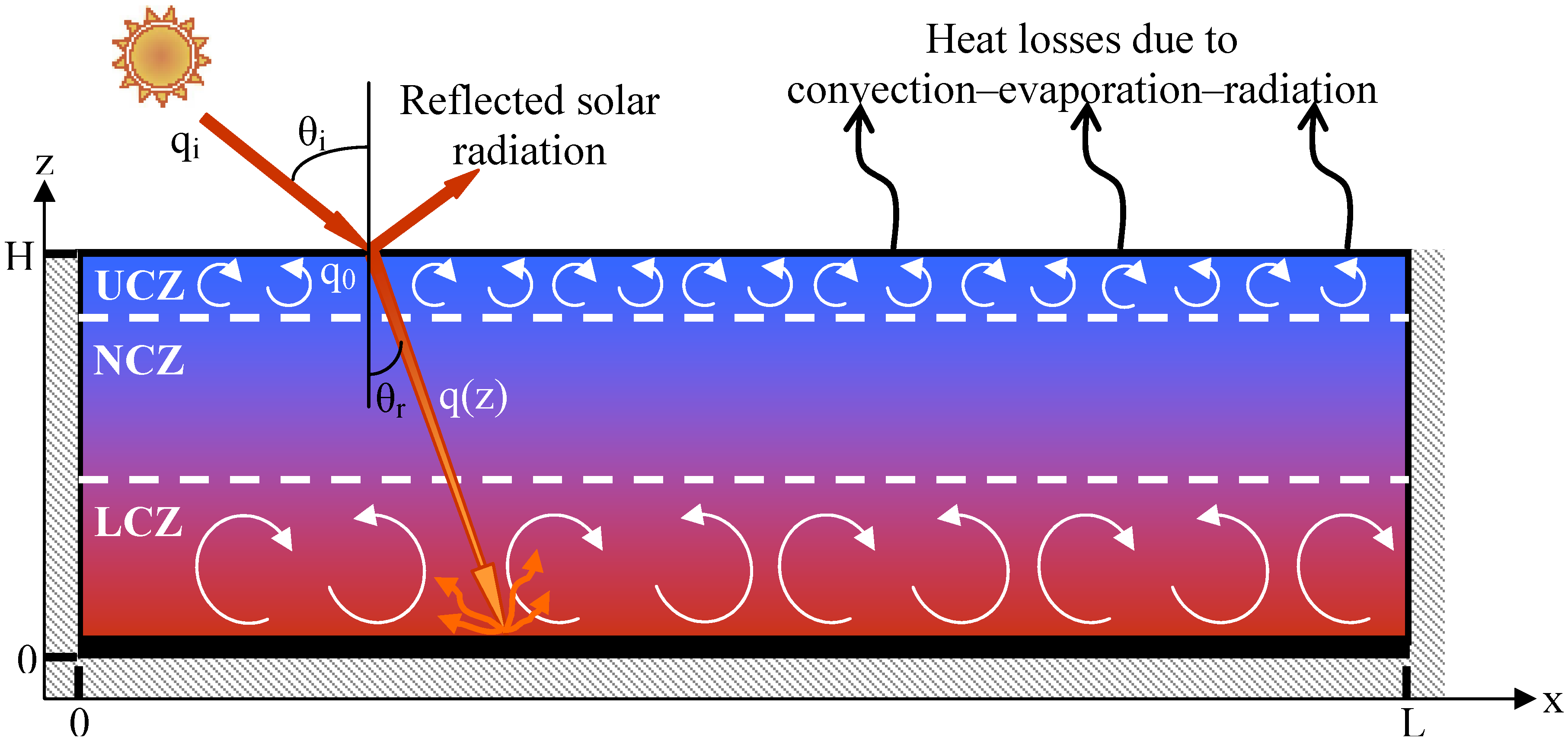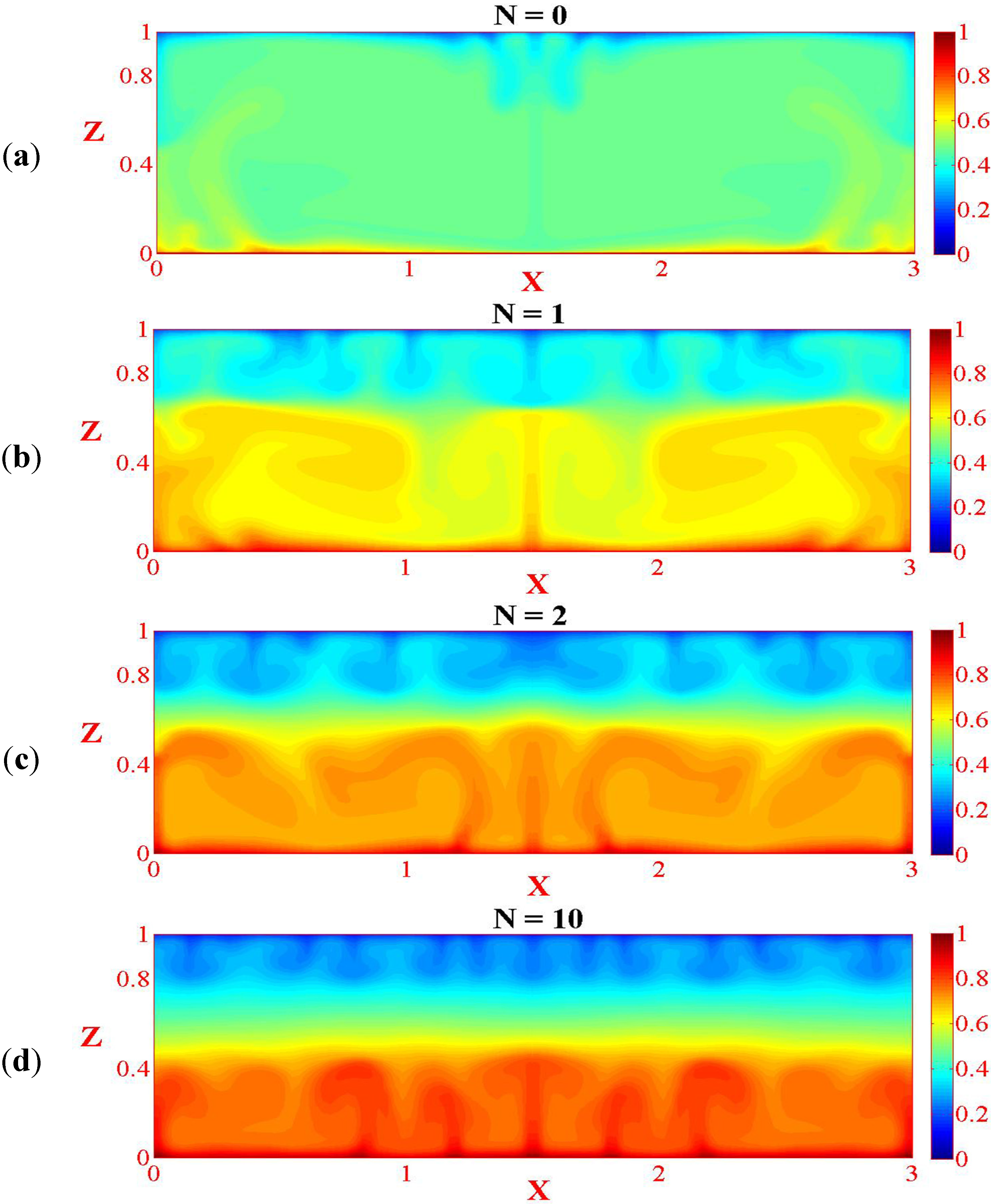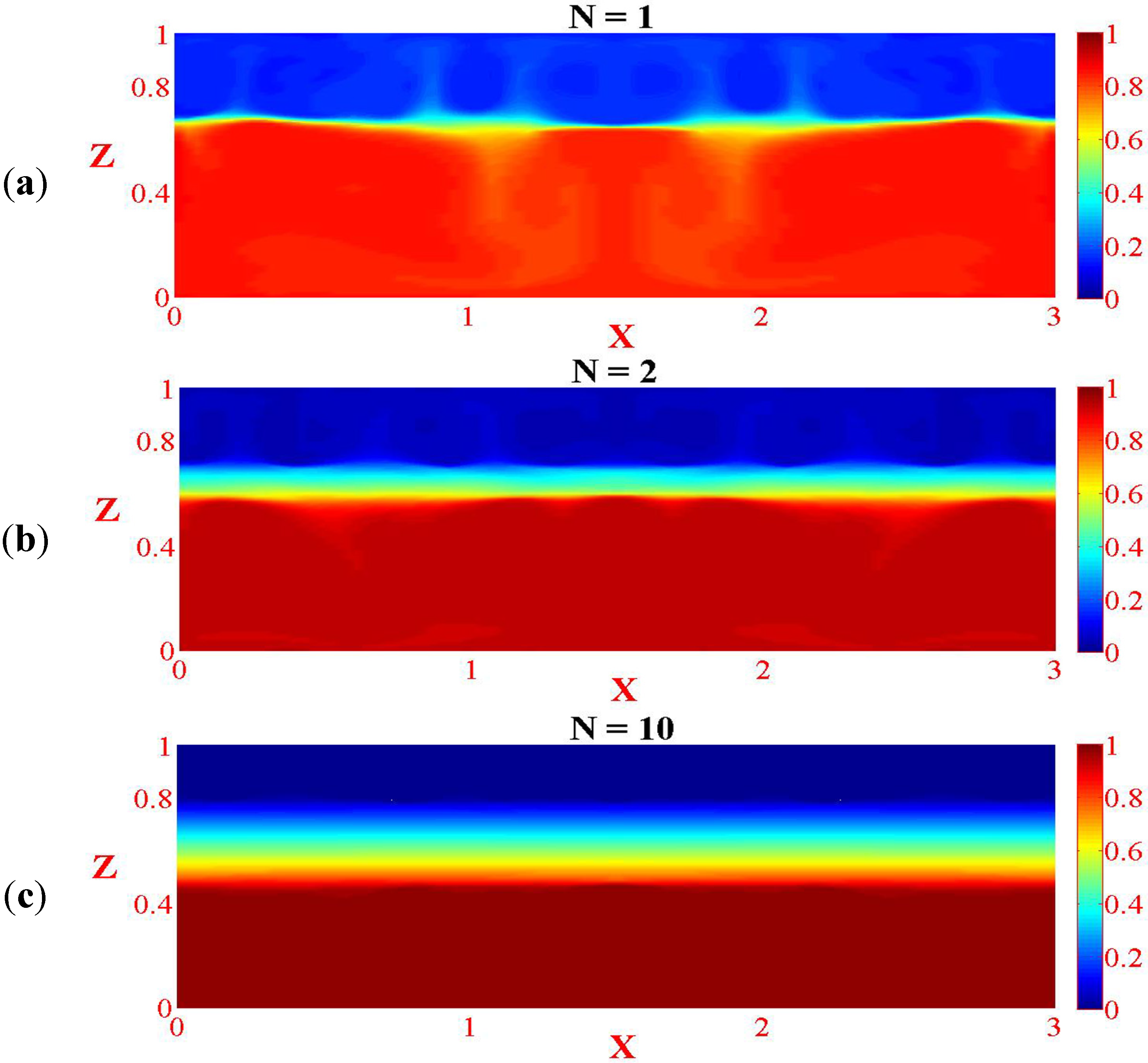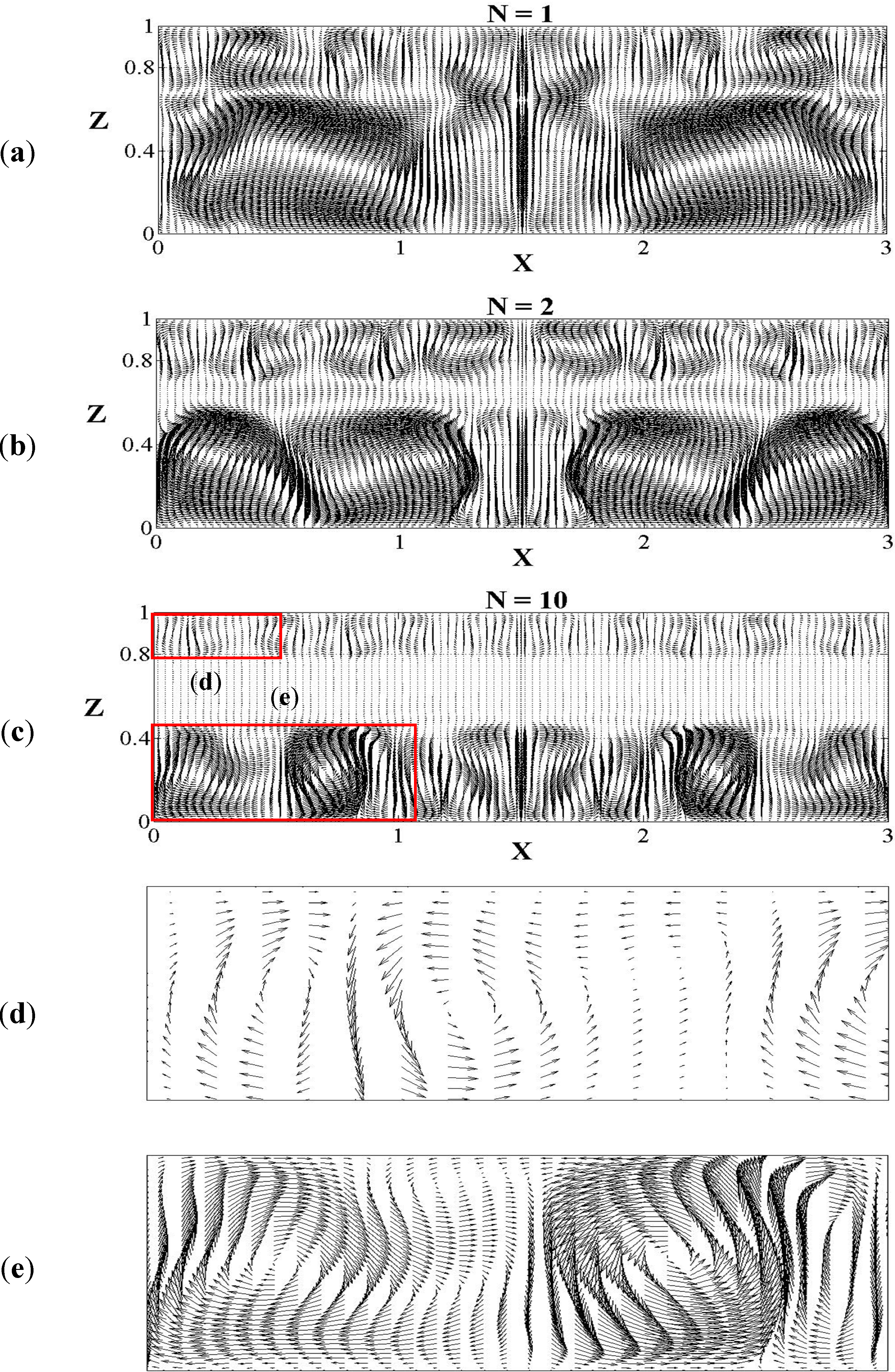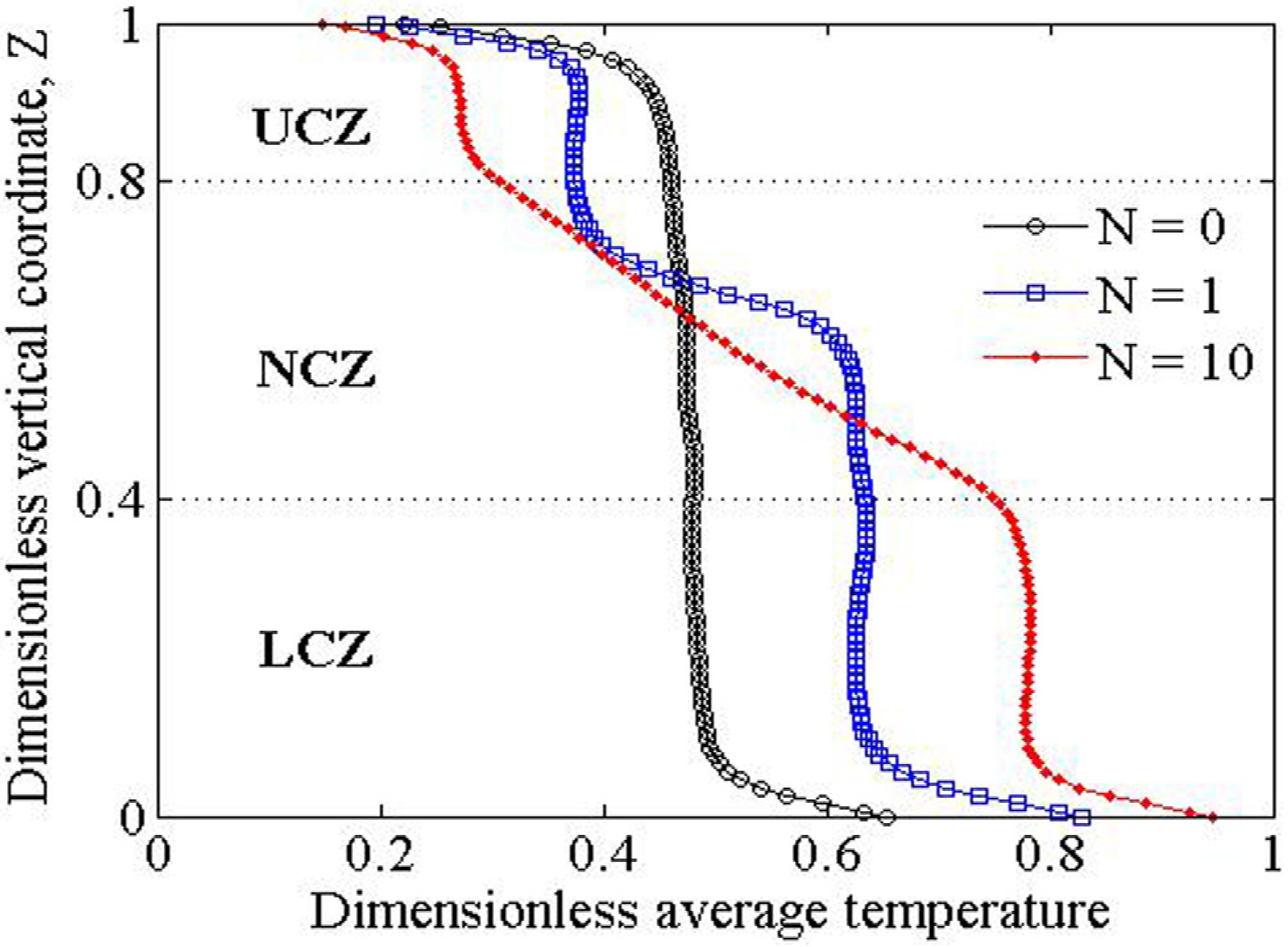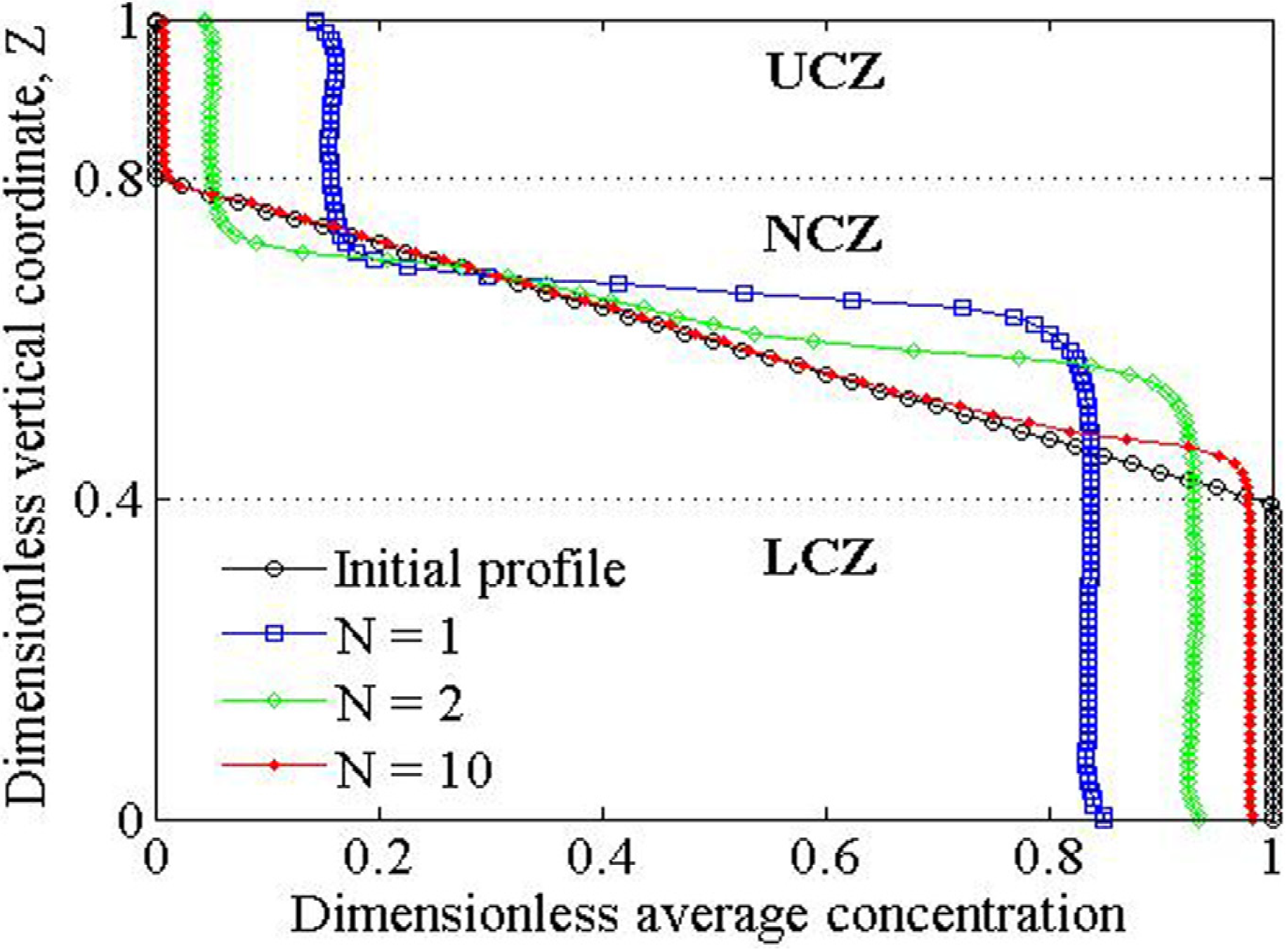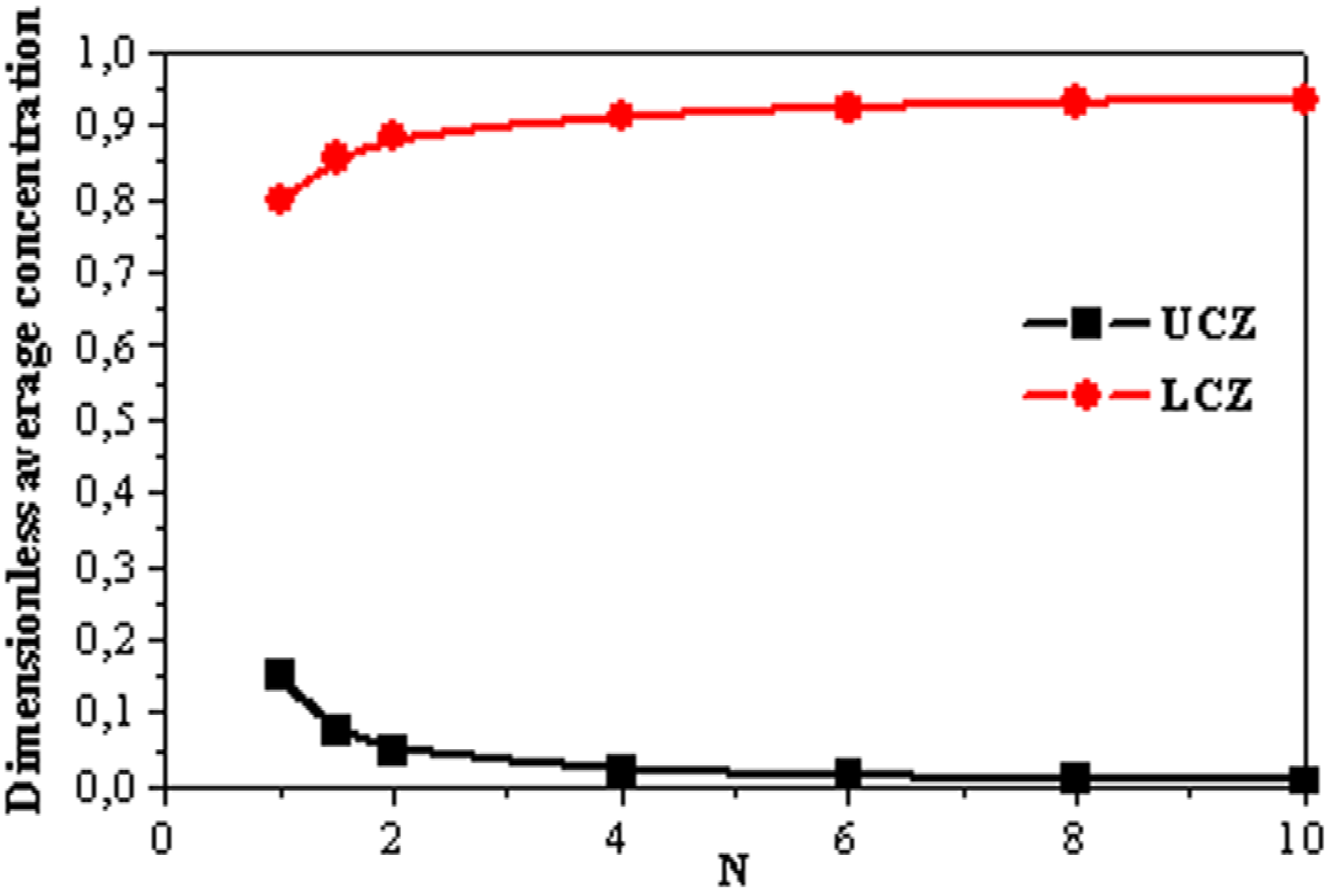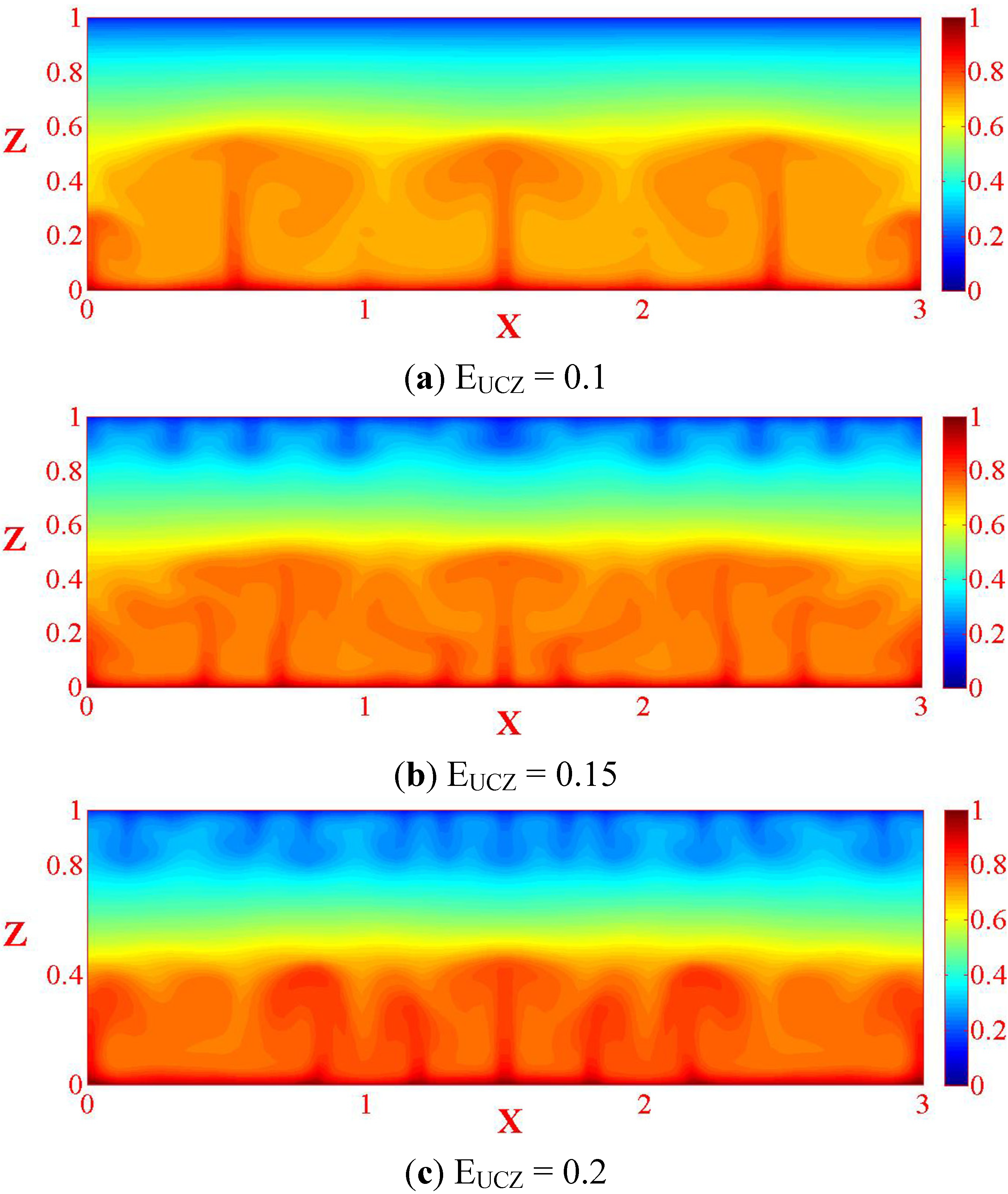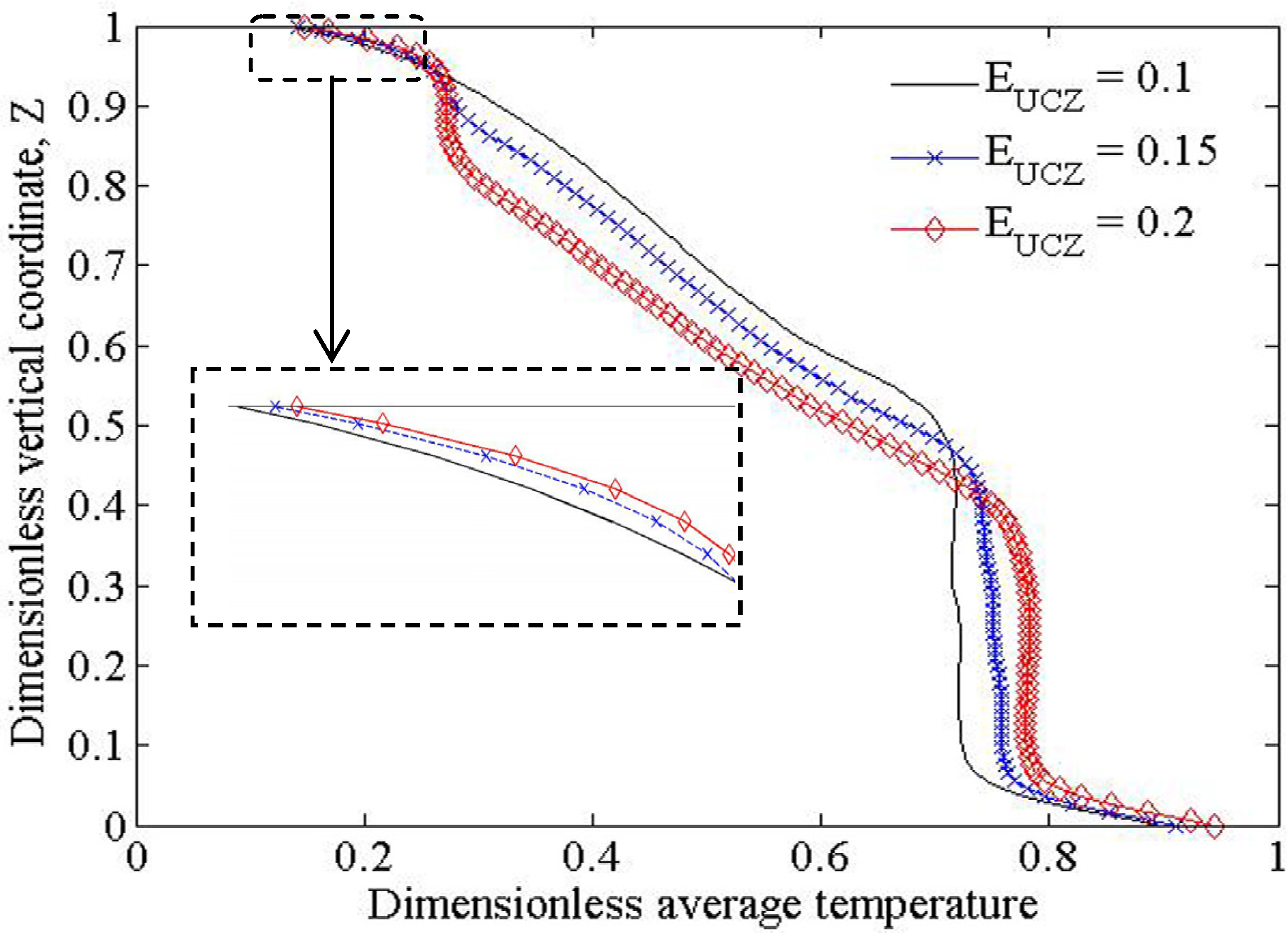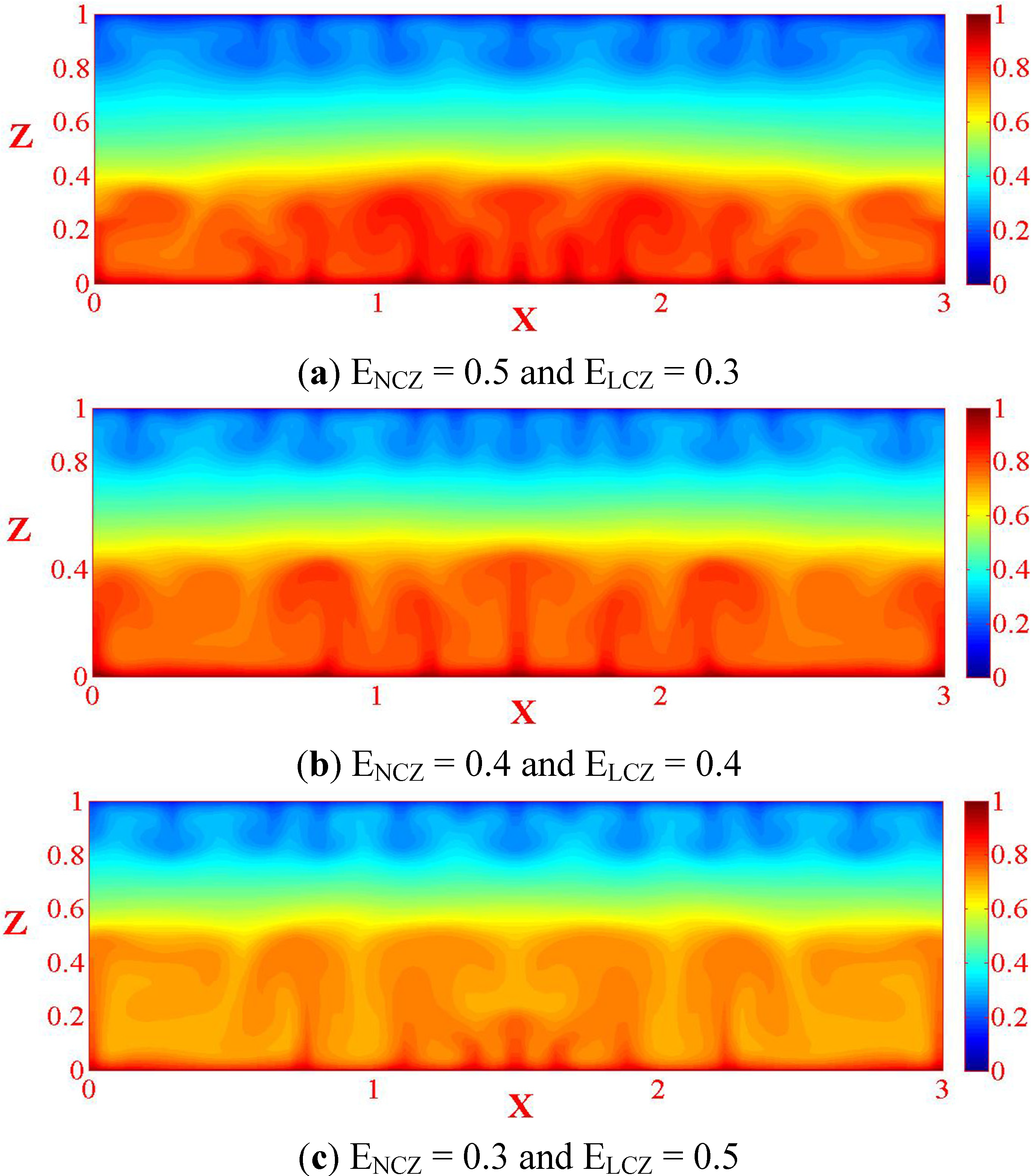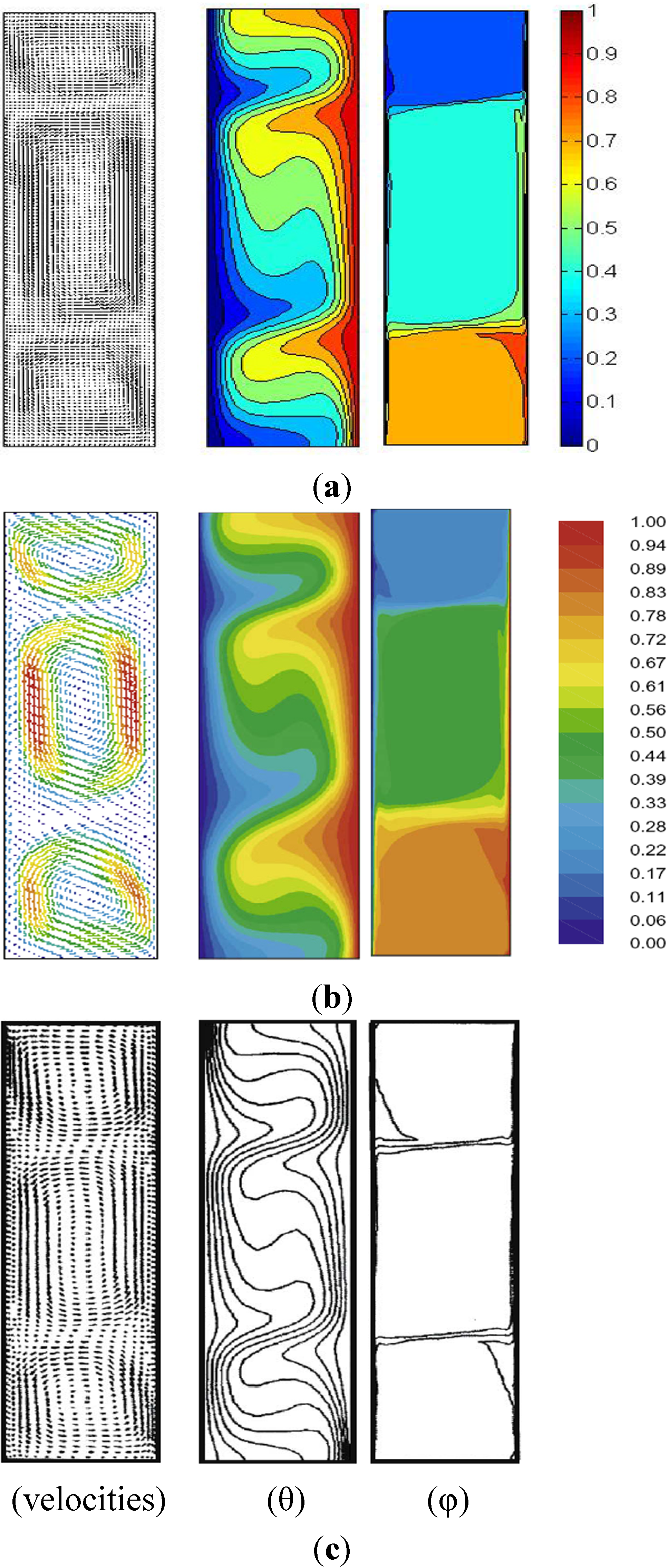1. Introduction
Solar radiation constitutes a huge energy source which is abundant and available almost everywhere. A salt gradient solar pond is a large solar energy collection pool which absorbs an important amount of solar energy radiation and stores it as thermal energy in the same medium for a long period of time (months, seasons or even a year).
Solar ponds can be employed to supply thermal energy in many applications, e.g., heating of buildings, production of electricity, desalination of sea water, textile processing and food industries, etc.
In this work a solar pond was filled with salty water of different concentrations to form three distinct zones. The first convective zone with a minimum salt concentration is called the upper convective zone (UCZ) and is situated on the top of the pond where the incident solar radiation is partially absorbed and the rest is transmitted to the zone below. The second convective zone is situated at the bottom of the solar pond and called lower convective zone (LCZ), which has a high temperature, and a maximum salt concentration. In this zone, solar radiation is absorbed and transformed to thermal energy. Therefore, it is an absorption and storage zone. These two zones are characterized by uniform concentration and separated by the important gradient zone called the non-convective zone which functions as a transparent insulator, permitting solar radiation to be trapped and stored in the bottom of the solar pond. In this zone, the salt concentration and the temperature increase with depth.
The study of solar ponds, including experimental, analytical and numerical investigations, has received much attention from numerous researchers. Kaushika
et al. [
1] and Bansal
et al. [
2] solved the one-dimensional equation of heat conduction with fluid internal heating due to solar radiation absorption. Giestas
et al. [
3] analysed the stability of the gradient zone of a solar pond taking into account solar radiation absorption. Kurt
et al. [
4] studied the performance of an uninsulated solar pond by developing one-dimensional transient heat conduction with internal heating of fluid. Their research shows that it is possible to store solar energy for a long period of time in a correctly planned solar pond. Hassairi
et al. [
5] studied experimentally the performance of natural brine solar pond near an area with high average value of solar radiation. They used the brine of Sabkhat el Hadibat in the southern region of Tunisia. In their research, the temperature is mostly uniform in the lower layer and exceeds 45 °C. This temperature decreases near the bottom of the pond due to the heat losses through the soil. For values of solar radiation and ambient temperature equals to 750 Wm
−2 and 32 °C, the temperature of the lower layer attains a maximum value of 47 °C. Husain
et al. [
6] studied numerically the thermal behaviour of solar pond. In their research, the temperature of UCZ is estimated by three different approaches. The approaches of Weinberger and Kaushik yield the same temperature while the approach of Joshi and Kishore yielded a smaller temperature. Husain
et al. [
7] proposed two simple formulations to estimate the solar radiation in a depth of a solar pond and took the universal functions of Hull [
8] as a baseline for comparison of accuracy in the estimation of solar radiation. Their results show that the two formulations provide a significant improvement (20%–25%) in computing time to simulate the thermal performance of a solar pond. Angeli
et al. [
9] studied numerically the salt diffusion and stability of the density gradient in a solar pond using a one–dimensional transient model. They calculated the optimum thickness of gradient zone and its transient behaviour, taking into account the seasonal solar radiation and the temperature of solar pond. Jaefarzadeh [
10] studied the thermal behavior of a salinity gradient solar pond. In this research work, the sensitivity analysis shows the importance of the wall shading effect to reduce the sunny area and the temperature of the LCZ. Mansour
et al. [
11] studied numerically the temporal evolution of thermal and solute transfer in a three-dimensional solar pond considering the influence of the external factors (solar radiation, wind velocity, ambient temperature,
etc.) on its stability characteristics. In their research work, the solar radiation has an important effect on the internal temperature and the stability of the solar pond. The solar heating effect is more important in a poor transparency pond. Mansour
et al. [
12] studied numerically the temporal evolution of thermal and solute transfer in a two-dimensional solar pond considering the influence of the external factors on its long-term thermal and stability characteristics. Their results show that the solar heating effect appears considerably stronger during the spring and summer than during the winter and autumn. Kurt
et al. [
13] studied experimentally the performance of a small solar pond under simulated solar radiation from two halogen-lamps. Also, they studied numerically the transient thermal and solute behavior in one-dimensional solar pond. In their experimental results, the use of salt (sodium-carbonate) in the density gradient zone permits the storage of a great quantity of solar energy as thermal energy in the LCZ for a long period of time. The numerical temperature difference between the surface and the bottom of the solar pond became higher than the experimental temperature difference. This distinction between the numerical and experimental profiles is caused by the solar simulator radiation. Karakilcik
et al. [
14] investigated experimentally and numerically the thermal performance of an insulated salt-gradient solar pond. They showed that the performance of the solar pond is affected strongly by the temperature of LCZ and the temperature profile with the depth of the pond. They also established that the introduction of other two zones (upper convective and non-convective) provides many conveniences to calculate the storage efficiency in the LCZ and to determine the relations with heat loads, and a best operating state. Hammami
et al. [
15] studied numerically the hydrodynamic and thermal behaviours in an enclosure with a vertical solute gradient but they did not take the solar radiation absorption into account. Ould Dah
et al. [
16] studied experimentally and numerically the performance and stability of a mini solar pond. Their experimental results show an increase of the mini pond daily average temperatures, which reached 54°C in the lower convective zone after twenty days. They developed again a one-dimensional model to study the thermal and solute behavior in the mini solar pond. In their research work, the efficiency of the mini solar pond could be improved considerably by using a new method of heat extraction from the NCZ. Suarez
et al. [
17] studied numerically the effects of double-diffusive convection on the heat performance and stability of a solar pond using a fully coupled two-dimensional model. Wang
et al. [
18] studied numerically the nonlinear dynamic behavior of the non-convective zone in a salt gradient solar pond. In their research work, the linear and nonlinear studies indicate that oscillation is a narrow region above the stable region. The nonlinear results indicate that the linear stability analysis leans to a larger upper boundary in the oscillatory regions.
In the previous studies, no attempt was made to describe the velocity, temperature and concentration field distributions in the salt-gradient solar pond. Hence, the temperature and the concentration are commonly assumed to be uniform in the entire of the LCZ and the UCZ, which is undoubtedly a simplifying hypothesis. Also, the effect of buoyancy ratio on the pond stability has not been studied.
Here, we present a two-dimensional numerical modelling of the hydrodynamic, heat and mass transfers in a salt-gradient solar pond and its stability. The pond is filled with salty water of different salinities to form three distinct salty water zones (upper convective, non-convective and lower convective). The movements of salty water are created in the UCZ and in the LCZ by double-diffusive natural convection induced by an internal heating process due to solar radiation absorption. Our objective is to supply by computations detailed knowledge of the hydrodynamic, thermal and solutal structures of the transient fluid flow developed in a salt–gradient solar pond during the collection and the storage of energy.
The resolution of continuity, momentum, thermal energy and mass transfer equations governing the hydrodynamic, heat and mass transfer developed in the solar pond is conducted using finite-volume method discretization in transient regime.
This numerical study is divided into six sections:
Section 1 introduces the importance of salt-gradient solar ponds to store a large amount of solar energy and their various applications.
Section 2 describes the configuration of the insulated solar pond and necessary simplifying assumptions.
Section 3 presents the equations of continuity, momentum, thermal energy and mass transfer governing the transient hydrodynamic, heat and mass transfer in the solar pond with internal heating of the fluid due to solar radiation absorption.
Section 4 describes the numerical method used in this work and validates the numerical code specifically developed for the problem of this study.
Section 5 discussed the effect of buoyancy ratio on the stability of the solar pond and on the average temperature and concentration profiles. This section analyzes again the effects of UCZ, NCZ and LCZ thicknesses on the thermal behaviour of the solar pond. The numerical study concludes in
Section 6.
2. Physical Model and Simplifying Assumptions
The body of the simulated solar pond is a two-dimensional rectangular enclosure of height H and length L filled with a mixture of water and salt.
Figure 1 shows the physical model of the solar pond under consideration.
Figure 1.
Schematic view of the insulated salt gradient solar pond.
Figure 1.
Schematic view of the insulated salt gradient solar pond.
Because different processes are occurring inside and outside the salt gradient solar pond, the operation of the solar pond is frequently complicated, so some assumptions were made to simplify the analysis of the hydrodynamic, thermal and solute behavior of the solar pond. The third dimension of the enclosure is assumed to be large enough so that the fluid flow, heat and mass transfer are two-dimensional. The fluid is assumed to be Newtonian and incompressible. The solar pond is constituted by three distinct zones: LCZ, NCZ and UCZ. The vertical walls of the solar pond are well insulated and impermeable. The free-surface of the solar pond is subjected to heat losses by convection, evaporation and radiation, and is impermeable. As shown in
Figure 1 a portion of solar radiation entering the pond is absorbed by the pond’s bottom and converted to thermal energy which is stored in the lower region of the solar pond. The bottom of the pond is painted in black in order to increase the solar radiation absorption. The bottom is assumed to be adiabatic and impermeable. The thermo -physical properties of the salty water do not vary with temperature and salt concentration, except density in the buoyancy term, which depends linearly on both local temperature and concentration,
i.e., the Boussinesq approximation is assumed to be valid:
where β
T = −1/ρ
0[∂ρ/∂T] and β
S = −1/ρ
0[∂ρ/∂C]
T.
The height of the pond (H) is taken as a reference length for the spatial coordinates (X = x/H; Z = z/H). The references for time, velocity, pressure, temperature and concentration are defined as follows: H2/α, α/H, ρα2/H2, ΔT and ΔC, respectively.
3. Mathematical Model for the Salt Gradient Solar Pond
The quantity, q(z), of solar radiation at different depths of salty water in the solar pond can be expressed as [
19]:
where q
0 represents the solar radiation that penetrates the free-surface of the solar pond, which is given by:
where q
i, is the incident solar radiation that reaches the free-surface of the solar pond and r is the reflectance of solar radiation at the free-surface of the pond. This coefficient is obtained from [
20]:
where θ
i is the angle of incidence; θ
r is the angle of reflection and k is a coefficient due to the effects of salt concentration, propagation of radiation in the layers of salty water and turbidity of water on the reduction of solar radiation. For the present study, θ
i = 60° and r = 0.06 [
21]. So, θ
r = 40.5° is obtained from Equation (4). The coefficient k is equal to 0.85 [
10]. γ
j and ε
j are dependent on the absorption of the particular wavelengths range of the arriving solar radiations. These constants γ
j and ε
j are as follows [
10,
22] (
Table 1):
Table 1.
Constants γj and εj.
Table 1.
Constants γj and εj.
| Wavelength | γ | ε |
|---|
| 0.2–0.6 | 0.237 | 0.032 |
| 0.6–0.75 | 0.193 | 0.45 |
| 0.75–0.9 | 0.167 | 3 |
| 0.9–1.2 | 0.179 | 35 |
Finally, Equation (2) is expressed as follows:
Under the above assumptions, the transient hydrodynamic, heat and mass transfer process in the solar pond with internal heating of the fluid due to solar radiation absorption is governed by continuity, momentum, thermal energy and mass transfer equations:
In Equation (9), the term S
R represents the rate of energy generation per unit volume in a fluid layer, which results from the solar radiation absorption by salty water. It is given by:
Introducing the following dimensionless groups defined by:
The dimensionless equations of continuity, momentum, thermal energy and mass transfer can be written as follows:
The dimensionless parameters that characterize the salt gradient solar pond are the aspect ratio A = L/H, the thermal Rayleigh number RaT = gβTΔTH3/(αν), the internal Rayleigh number RaI = gβTq0H4/(λwαν), the solutal Rayleigh number RaS = gβSΔCH3/(αν), the buoyancy ratio N = βSΔC/(βTΔT), the Prandtl number Pr = ν/α, the Schmidt number Sc = ν/D and the Lewis number Le = Sc/Pr.
Initially, the fluid is considered in rest condition and at ambient temperature, so the dimensionless temperature, pressure and velocities have initial values equal to zero. The solar pond is initially (τ = 0) filled with water and subdivided into three zones in where the dimensionless salt concentrationsare as follows:
The boundary conditions on the vertical walls and on the bottom of the pond are: U = W = 0. The vertical walls of the pond are supposed to be adiabatic and impermeable. At the bottom and the free-surface of the solar pond, we imposed a zero flux of mass. The boundary condition for velocities on the free-surface is: ∂U / ∂Z and W = 0. For reasons of symmetry, we consider only the half of the pond:
The boundary conditions for heat flux at the bottom and the free–surface of the solar pond are detailed in
Appendi 4. Numerical Method and Validation
Equations (13–17) were solved using the finite-volume method developed by [
23]. The discretization method and numerical solution procedure used have been described in detail elsewhere [
24]. Only the main features are given here. First, the domain of the enclosure is subdivided in elementary volumes Ω
Φ defined in a Cartesian two-dimensional coordinates. The transport equation is then integrated in each of these volumes, expressing the balance of flux “J
Φ” of the transport parameter “Φ” which represents the components of velocity vector (U and W), temperature (θ) or concentration (φ):
The volume integral of the divergence of
is changed into surface integral:
where Σ is the surface area covering the control volume Ω
Φ;
is the outward unit normal to the differential surface area ds and
represents the flux term of Φ, which is expressed by:
where Г
Φ is the diffusion coefficient; and S
Φ a source term evaluated explicitly.
The definition of Φ, Г
Φ, S
Φ and of the flux term
for each equation is given, in dimensionless form, in
Table 2.
Table 2.
Diffusion coefficients, flux and source terms of variable Φ.
Using a staggered grid, three different control volumes are defined for a given node point: one for each of the two vector components and one for the scalar variables. Then, each of the transport equations is integrated over its own control volume. The spatial discretization of the governing equations is obtained using the hybrid scheme interpolation.
The temporal integration over a time step has begun using the Alterning Directions Implicit (ADI) method (Peaceman and Rachford [
25]) which produces two separate tridiagonal matrices for each equation.
The pressure-velocity coupling was handled by the Semi-implicit Method for Pressure-linked Equation Revised (SIMPLER) algorithm [
23]. This algorithm consists of correcting velocities predicted with the momentum equations. As the pressure correction equation is solved until convergence, we obtain the pressure field, and therefore the estimated velocities are corrected to fit the equation of continuity.
A computational domain consisting of 50 × 100 grid points with uniform grid spacing in OX and in OZ directions and a dimensionless time step equal to 10−8 were found to be sufficient for producing accurate results at reasonable computed time.
In order to check on the accuracy of the numerical code specifically developed for the solution of the problem considered in the present work, it was validated by performing computational simulation for double-diffusive natural convection, which is reported earlier by Han and Kuehn [
26] and Suarez
et al. [
17]. In this case,
Figure 2 shows comparison for velocities, temperature and concentration fields of the present numerical study and the numerical results published by Han and Kuehn [
26], and Suarez
et al. [
17]. Computations are performed for opposing buoyancy conditions with the constant following parameters: Ra
T = 3.2 × 10
6, Ra
S = 2.4 × 10
7, A = 1/4, Sc = 2000 and Pr = 8.
Figure 2 shows a good agreement between both results.
Figure 2.
Comparison of velocities, temperature (θ) and concentration (φ) fields between the present study (
a) and previous studies reported by Suarez
et al. [
17] (
b), and Han and Kuehn [
26] (
c); (Ra
T = 3.2 × 10
6, Ra
S = 2.4 × 10
7, A = 1/4, Sc = 2000 and Pr = 8).
Figure 2.
Comparison of velocities, temperature (θ) and concentration (φ) fields between the present study (
a) and previous studies reported by Suarez
et al. [
17] (
b), and Han and Kuehn [
26] (
c); (Ra
T = 3.2 × 10
6, Ra
S = 2.4 × 10
7, A = 1/4, Sc = 2000 and Pr = 8).
